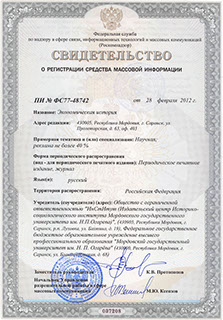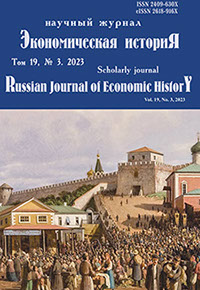Экономическая историЯ
Russian Journal of Economic History
ISSN 2409-630X (Print)
ISSN 2618-916X (Online)
Expert board:
- Scientific Council of RAS on economic history;
- Research and Educational Center «The economic history of Central Russia and the Middle Volga region» of Ogarev Mordovia State University;
- Center of Economic History of Lomonosov Moscow State University
Navigation
Certificate of registration

ISSN 2409-630X (Print), ISSN 2618-916X (Online)
DOI: 10.15507/2409-630X.062.019.202303.267-274
Tаtiana V. Shitova1, Sergey V. Pershin2
1 Far Eastern Law Institute Ministry of Internal Affairs of the Russian Federation (Khabarovsk, Russia),
e-mail: shitova.tv@mail.ru
2 Research Institute of Humanities under the Government of the Republic of Mordovia, National Research Ogarev Mordovia State University (Saransk, Russia),
e-mail: Pers99@inbox.ru
Payment for Occasional Religious Rites in the Income Structure of the Orthodox Clergy in the Late 19th – Early 20th Century (Based on the Materials of the Mordovian Region)
Abstract
Introduction. One of the main functions of the parish clergy in the late 19th – early 20th century was to perform church rites and “sacraments” at the request of parishioners. The payment for the correction was perceived by a certain part of the parishioners as additional levies and served as a reason for the growth of social tension. The article attempts to update the study of this source of funding for the clergy and clergy in the context of socio-economic development of the region.
Materials and Methods. The research is based on general scientific and special historical methods (comparative historical, problem-chronological, systemic and structural).
Results. The main difficulties in conducting the study are related to the fact that, for ethical reasons, the ROC did not introduce a tariff for demand correction and the diocesan authorities did not control this part of the income of the clergy. In this regard, complete and objective data on the income of clerics from the demand for correction are found in the documents of spiritual consistories quite rarely. Clerics and parishioners privately negotiated prices for occasional religious rites. In the parishes of neighboring counties, approximately similar prices were set for occasional religious rites. According to available information, the established norms were often advisory in nature.
Discussion and Conclusion. The analysis of the source base allowed us to identify some features of the church documentation related to the desire of the clergy not to show the real size of their income. These include the careless maintenance and destruction of notebooks in which the money received for the occasional religious rites was recorded, the fixation of the income of the clergy directly by the clergy (or their spouses), who received the bulk of the funds collected from the population. In parishes with vacant places, the priests were afraid of withdrawing part of the money in favor of diocesan guardianship.
Keywords: clergy, priest, clergy, parishioners, church rites and sacraments, occasional religious rites.
For citation: Shitova T. V., Pershin S. V. Payment for Occasional Religious Rites in the Income Structure of the Orthodox Clergy in the Late 19th – Early 20th Century (Based on the Materials of the Mordovian Region). Ekonomicheskaya istoriya = Russian Journal of Economic History. 2023; 19(3): 267–274. (In Russ.). DOI: 10.15507/2409-630X.062.019.202303.267-274.
© Ogarev Mordovia State University. History and Sociology Institute, 2017
68, Of. 411, Bolshevistskaya St., 430005, The editorial office of the scholarly journal «Russian Journal of Economic History»
Tel.: (8342) 24-25-90; 27-07-11, Fax: (8342) 24-25-90, E-mail: jurnal-econom-hist@isi.mrsu.ru
Designed by A. Napalkov, Email: napalkov@isi.mrsu.ru

